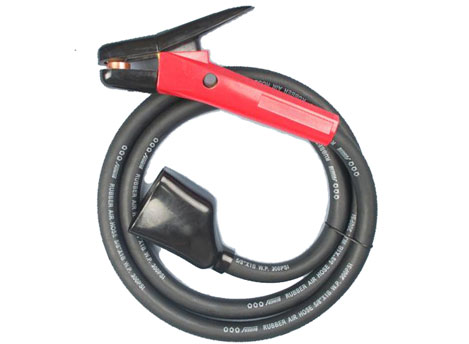Air carbon-arc gouging removes metal through the intense heat of an arc created between a carbon electrode and the workpiece. As the material melts, compressed air, which is directed through outlets in the lower jaws of the torch holding the electrode, lifts the molten metal clear of the arc before the metal solidifies.
The air carbon-arc gouging process does not require oxidation to maintain the cut, so it can gouge or cut metals that the oxyfuel process cannot. In fact, most common metals (carbon steel, stainless steel, high-alloy wear plate, copper alloys and cast irons) can be cut using air carbon-arc gouging.
Typical applications include the back-gouging of weld seams to reach the deposited weld metal from the other side of the workpiece, the removal of gates and risers from castings, the removal of old or excess weld metal so that equipment can be repaired and the reshaping of torn metal prior to welding repair, notably on construction equipment.
The rate at which metal is removed is based on the efficiency of the air stream, diameter of the carbon electrode, output of the welding power source and skill of the operator. Fortunately, learning the air carbon-arc gouging process only takes practice.

Choose a torch
A manual gouging torch and cable assembly includes connections for the welding lead and compressed air line. Be sure to size the torch and ground cable appropriately based on amperage and length of the cable. An insulated connection boot and hookup kit simplifies torch hookup and eliminates the possibility of arcing when contacting electrically hot parts.
The manual torch holds the carbon electrode in a swiveling head so that the air jets stay aligned with the electrode regardless of angle. Most torches have one set of air jets, but some have air jets on two sides of the electrode, which are better for some uses, such as removing pads and risers from large castings (padwashing).
Manual torches are usually air-cooled. For high-current applications, water-cooled cable assemblies may be used with heavy-duty torches.
Strike an arc
Strike an arc by lightly touching the carbon electrode to the workpiece. Let the arc start and slowly move it forward or side to side as needed to accomplish the goal. Striking the arc is a little bit different and slightly easier than with a welding electrode. Prior to striking, take the necessary time to get into a comfortable position, and do not draw the electrode back once the arc is struck.
The air carbon-arc gouging process operates between 35 V to 55 V. Listen for a loud arc, which indicates sufficient voltage (note: wear hearing protection when gouging). A muffled arc means the voltage is too low, which could result in carbon deposits.
The above information is provided by the gouging torch supplier.






